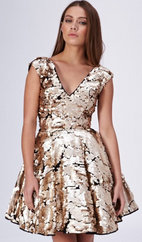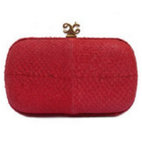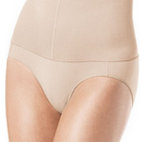In the news: The changing habits of London’s shoppers
The Evening standard ES magazine is always given out during London Fashion week, and while the Girl Meets Dress team were at the shows this weekend they enjoyed reading this feature by Kate Wills on how our complicated relationship with buying clothes is just the tip of the iceberg. Ethical shopping is on all of our lips, but fast fashion is still booming. Luckily, renting fashion is an option available to all women.
Read the article below or click here to visit the Evening standard website >
“The posters pasted up on Tube stations across London tell one story, the people in front of them another.
Often, if you ask commuters standing near the omnipresent adverts for brands such as Boohoo, Missguided or PrettyLittleThing they will tell you that they are buying more expensive, longer-lasting items, and fewer of them. According to ES Magazine’s readers’ survey, 34 per cent of you say that environmental concerns are affecting your spending habits (far more than Brexit is), and 53 per cent now shop with sustainability in mind, yet also admit that whether a garment is on-trend is a higher priority than the ethics of how it was made.
The majority of readers say they like shopping on the high street, but last year an average of 16 stores closed per day, with high-profile casualties including House of Fraser, Debenhams and LK Bennett. Meanwhile, online ‘rapid fashion’ retailers are posting record profits: Boohoo’s revenues jumped to £857 million this year and Missguided, which launched its now infamous £1 bikini during the Love Island ad break, was recently valued at £700 million.
London is one of the shopping capitals of the world, but the way Londoners are buying clothes is, well, all over the shop.
‘Shopping habits are in flux because consumers are in flux, especially millennials, who are the most contradictory generation of all time,’ says Melanie Arrow, head of strategy at ad agency BMB. ‘We say we care about the environment, but we engage with fast fashion. We say we want brands to do good in the world, and yet we’ll queue round the block for the latest trainer and support the extremes of capitalism. But when it comes to the environment, the cultural mindset has definitely shifted. It’s no longer hippy or alternative to take your own bags to the shops and use reusable cups or bottles; it’s simply being conscious. And that is extending to our wardrobes.’
Indeed, the impact of fashion on the environment is now impossible to ignore, even for die-hard shopaholics. British shoppers throw away a million tonnes of clothing a year. As well as contributing to landfill, our wear-once, throw-away mindset is fuelling the textile industry’s 1.2 billion tons of greenhouse gas emissions a year — more than international flights and maritime shipping combined. Not to mention that making clothes consumes lake-sized volumes of fresh water and creates chemical and microplastic pollution. It is estimated that the fashion industry, said to be the second-largest polluter after the oil industry, could by 2050 be responsible for a quarter of the Earth’s carbon budget needed to keep the global temperature rise to 2 degrees Celsius. And yet in June, ministers rejected plans for a 1p per garment levy to tackle fast fashion. They also refused to support a ban on incinerating clothes and a reduced tax rate for clothes repair services — something already implemented in Sweden.
There are calls from climate protesters for us to follow the eco-minded Swedes in other ways, too. In July, the Swedish Fashion Council announced that it was cancelling Fashion Week due to concerns about sustainability. Extinction Rebellion picketed London Fashion Week for the first time in February, and at the time of going to press was expected to be an even stronger presence this season. With the sustainability conversation louder than ever, we’re all looking for ways to make our closets more conscious. Agatha Lintott, a former buyer for Burberry, set up Antibad — dubbed ‘the Net-a-Porter for green style’ — last year.
LA-based sustainable fashion brand Reformation is opening its first London store in Westbourne Grove this month. And even the high street is jumping on the bandwagon in the hope of wooing back woke shoppers. Zara announced in July that all of its clothes will be made from sustainable fabrics by 2025, Primark has brought out sustainable cotton jeans and pyjamas, and H&M has its Conscious range of more eco-friendly options, plus an in-store recycling programme. Even Boohoo (which recently bought up Karen Millen and Coast’s online operations) launched a sustainable collection in June.
But critics are sceptical about this green-washing, not least because the technology doesn’t exist to recycle blended textiles. Ethical shopping expert Lucy Siegle has pointed out that it would take H&M up to 12 years to make garments out of just 1,000 tons of clothing waste. Meanwhile, it produces that same volume of new clothes in a matter of days.
‘I’ll often read an article where it says, “top five sustainable brands”, and I’m, like, they’re not, they’re not, they’re not,’ says Amy Powney, creative director of the sustainable British fashion label Mother of Pearl. ‘You’ve got a lot of people putting out sweeping statements, thinking, “If I don’t start talking about sustainability, then I’m out of the cool crew.” Unfortunately for customers, you have to properly connect to the brand to see if it’s authentic because people are completely green-washing. It’s very depressing actually.’
Aja Barber, a fashion writer who focuses on sustainable fashion, is equally scathing of the ratings apps that allow consumers to discover how ethical their favourite brands are, such as Good On You. ‘It’s not one size fits all, so I don’t think you can apply certain measures to every single brand, whether they have 5,000 stores or 150 stores,’ she explains. ‘The bottom line is, we all need to buy less and shop with small designers. It doesn’t have to be more expensive — if you’re buying dresses in H&M or Zara, you can afford an independent designer on Etsy.’
The mantra might be ‘buy less, buy better’, but it might soon be ‘buy less, rent instead’. Good news for the 47 per cent of us spending less than £50 a month on clothes. A recent study by Westfield found that the UK clothing rental market has a potential value of £923m, and is forecast to boom over the next few years. While the concept has been big in the US for a while, it has been slow to take off this side of the pond. According to our survey, just 1 per cent of us are currently renting clothes. However, an influx of glossy new online platforms, such as London-based app The Nu Wardrobe, Hurr Collective and My Wardrobe HQ, could change all that.
‘A year and a half ago no one really cared about sustainable fashion; now it’s booming,’ says Victoria Prew, co-founder of Hurr Collective, which built up a 5,000-strong waiting list for its peer-to-peer lending of dresses from the likes of Ganni, Rixo and Chanel. ‘The sharing economy has disrupted all other areas of our lives, from cars to holiday homes to pets, and our wardrobes are lagging behind. We’re not a jumble sale like eBay, we’re an aspirational curated e-commerce site. Sustainability is the number-one driver for us, so all our packaging is fully recyclable and we deliver by bicycle.’
Social media has no doubt affected our shopping habits, too. A survey by Barnardo’s found that one in seven women wouldn’t re-wear a dress she had been photographed in. But rather than ‘wardrobing’ (that’s wearing an item and then returning it, FYI), renting or reselling clothes might be the solution. Second-hand clothing websites such as Vestiaire Collective, ThredUp and, of course, eBay, are growing 21 times faster than the high street and will be worth $52bn in five years. There’s also Bundlee, the UK’s first baby clothing rental subscription service.
In the era of ‘peak stuff’, the purpose of shopping, and what we expect from a store, is changing. ‘Offline shopping needs to become more pleasurable and stimulating if it wants to compete with the online giants,’ says Jen Musgrave, senior strategist at advertising agency Rapp UK. ‘That’s why experiential retail is the latest movement.’ She points to Samsung, which hasn’t just opened a store in Coal Drops Yard, but rather a ‘creative and digital playground’. Next year The Outernet, a 2,000 capacity ‘cultural amphitheatre’, will open on Tottenham Court Road. Here, 360-degree, high-resolution, floor-to-ceiling screens will provide ‘product sampling’, allowing shoppers to try on 3D products. How this will translate into sales remains to be seen, although retailers will be able to use customer data to suggest outfits.
Online retailers are also upping their AI game to provide a better customer experience. Amazon Echo Look (already available in the US and coming soon to the UK) will take photos and videos of your outfit while you ask, ‘Alexa, how do I look?’, and then send you styling advice and suggestions for clothes to go with what you already own. Retailers including Net-A-Porter are already experimenting with incorporating data from your calendar — about a future trip, and what the weather forecast is for that location, for instance — and using algorithms to suggest outfits accordingly.
I meet Charlotte Turner, head of sustainable fashion and textiles for Eco-Age, in a juice bar around the corner from Primark, Oxford Street. Though just feet away shoppers are scrambling for £15 maxi dresses and £2 sunglasses, Turner looks chic in a white top she made from a vintage French bed sheet, and linen trousers. Eco-Age, which was founded by Livia Firth, provides consultation to businesses including Matchesfashion.com and Marks & Spencer on how to operate more sustainably.
‘Not so long ago people thought sustainable fashion meant unflattering designs and low-quality fabrics,’ says Turner. ‘That couldn’t be further from the truth. There are some amazing fabrics and initiatives out there: for example, Burberry recently developed a collection with Econyl regenerated nylon, which is made from reclaimed fishing nets, fabric scraps and industrial nylon waste. We’re also seeing fashion colleges actively educating the next generation about social and environmental sustainability and how to integrate it across their work; it’s not just an afterthought. We’re continuously involved in mentoring emerging designers as well.’
Turner is keen to stress that caring about the environment doesn’t have to suck the joy out of fashion — 79 per cent of respondents to our survey said they enjoyed shopping. ‘Buying clothes that are made with care and attention to communities and the environment actually makes the process of shopping more meaningful,’ she says. ‘We can celebrate the brands that are working in positive ways, and encourage those that have progress to make. It is possible to have a transparent supply chain, responsibly produced materials, a low environmental footprint — and an incredible outfit.’


 Designer A-Z
Designer A-Z 








